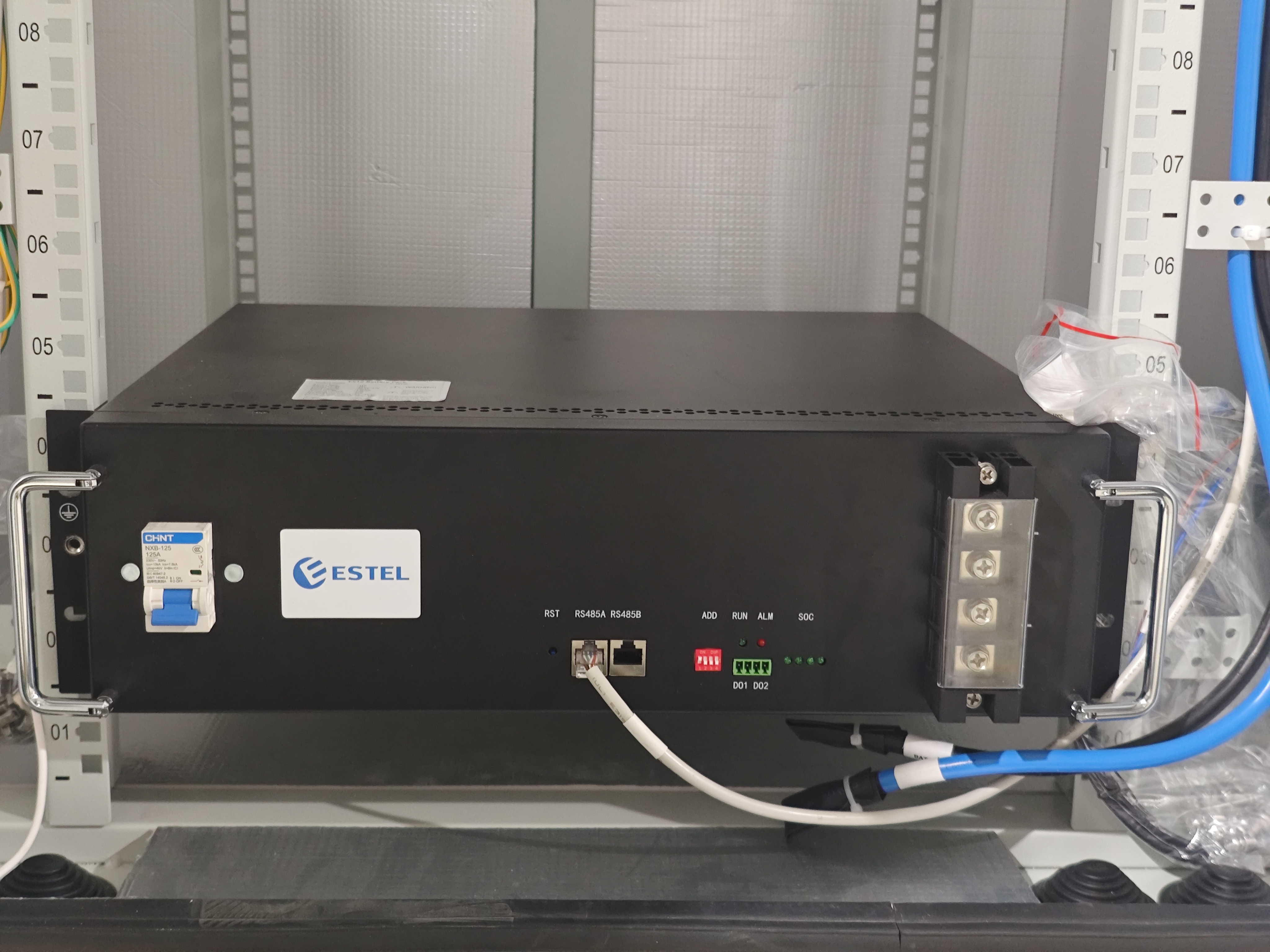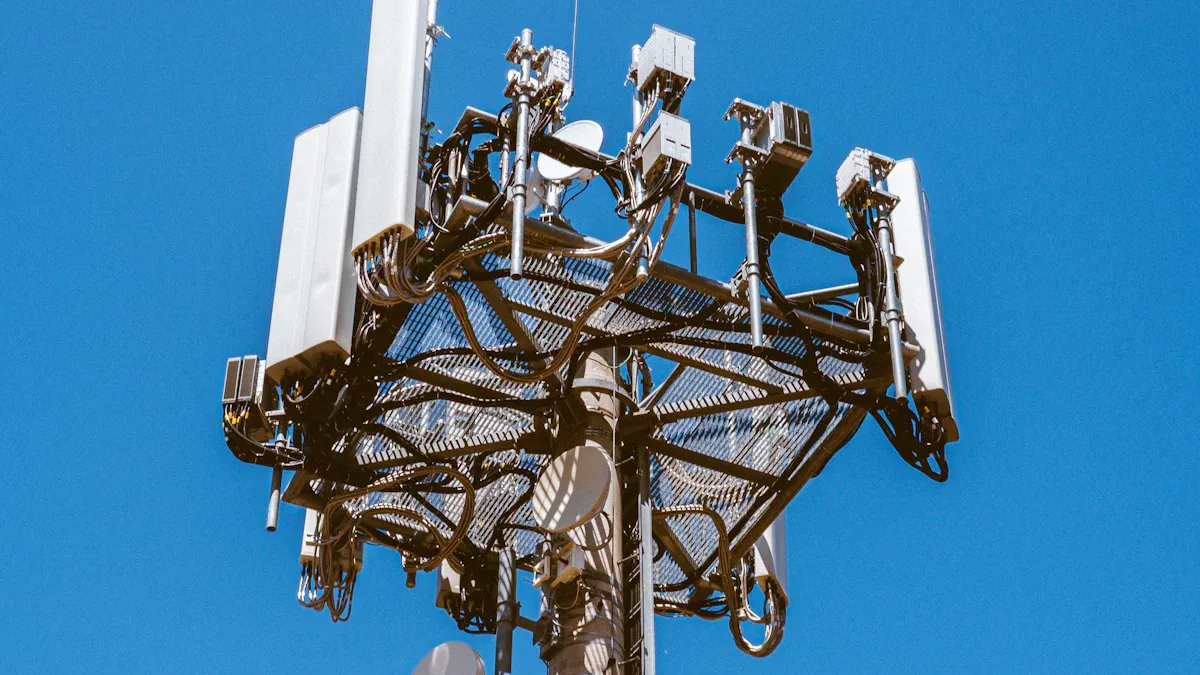ESTEL Telecom Battery Bank Setup and Maintenance Guide

Proper setup and maintenance of a telecom battery bank ensure reliable energy storage and delivery. When batteries operate efficiently, they support uninterrupted communication services, even during power outages. Neglecting maintenance or improper configuration can reduce performance, shorten battery lifespan, and lead to costly downtime.
You must also monitor charging processes to avoid overcharging or undercharging. Both can damage the battery bank and compromise its reliability. A well-maintained system not only extends battery life but also improves overall performance, keeping your equipment running smoothly.
Key Takeaways
Figure out how much energy you need each day. This helps your batteries last longer and work well.
Pick the right voltage for your battery setup. Higher voltage saves energy and works better for telecom use.
Charge your batteries evenly to keep them healthy. This stops problems that can make them wear out faster.
Check your batteries often and replace old ones quickly. This avoids sudden breakdowns and keeps power steady.
Stay safe when working on batteries. Look at them often and wear safety gear to avoid accidents.
Sizing the Telecom Battery Bank

Proper sizing of a telecom battery bank is essential for ensuring reliable power delivery and optimal performance. By calculating your energy needs and understanding the technical aspects of battery configurations, you can build a system that meets your requirements effectively.
Determining Watt-Hour Capacity
To size your battery bank correctly, you need to calculate your daily watt-hour needs. This involves determining the total energy consumption of your telecom equipment over a 24-hour period. Multiply the power rating (in watts) of each device by the number of hours it operates daily. Add these values together to get your total daily watt-hour needs.
Once you know your energy requirements, consider the depth of discharge (DoD) for your batteries. Most batteries should not be discharged below 50% of their capacity to avoid damage. For example, if your daily watt-hour needs are 5,000 watt-hours, you should size your battery bank to provide at least 10,000 watt-hours of capacity. This ensures the batteries operate within safe limits and last longer.
Tip: Always account for inefficiencies in the system, such as energy losses during charging and discharging. Adding a 20-30% buffer to your calculated watt-hour capacity can help maintain reliable performance.
Choosing the Right Voltage for Your Battery Bank
The voltage of your battery bank depends on the requirements of your telecom equipment and the overall system design. Common voltage options include 12V, 24V, and 48V. Higher voltage systems, such as 48V, are often preferred for telecom applications because they reduce current flow, minimizing energy losses and allowing the use of thinner cables.
When selecting the voltage, ensure compatibility with your inverter and other components. A mismatch can lead to inefficiencies or even damage to your equipment. Higher voltage systems also tend to be more efficient for larger setups, as they reduce the strain on individual batteries.
Configuring Batteries in Series vs. Parallel
The configuration of your battery bank—whether in series, parallel, or a combination of both—affects its voltage, capacity, and overall performance. Understanding the differences between these configurations helps you make the right choice for your system.
Series Configuration
Connecting batteries in series increases the voltage while keeping the capacity constant. For example, connecting four 12V batteries in series results in a total voltage of 48V, but the capacity remains the same as a single battery. This configuration is ideal for applications requiring higher voltage.
Advantages:
Voltage amplification for high-voltage equipment.
Uniform current distribution across all batteries.
Disadvantages:
The entire system depends on the weakest battery. If one fails, the whole series is affected.
Overcharging or imbalanced discharge can damage the batteries.
Parallel Configuration
Connecting batteries in parallel increases the capacity while keeping the voltage constant. For instance, connecting four 12V batteries in parallel results in a higher capacity, but the voltage remains at 12V. This setup is suitable for applications requiring extended runtime.
Advantages:
Increased capacity for longer operation.
Balanced performance and longevity among batteries.
Disadvantages:
Voltage remains constant, limiting applications needing higher voltages.
Requires careful management to ensure consistent performance.
Feature | Series Connection | Parallel Connection |
|---|---|---|
Voltage | Stays the same (equal to one battery) | |
Capacity | Stays the same | Increases (sum of individual capacities) |
Current Distribution | Limited by weakest battery | Shared among all batteries |
Applications | High voltage requirements | High capacity requirements |
Note: Many telecom battery banks use a combination of series and parallel configurations to achieve the desired voltage and capacity. For example, you might connect several batteries in series to reach 48V, then connect multiple series strings in parallel to increase capacity.
By carefully considering your energy needs, voltage requirements, and configuration options, you can design a telecom battery bank that delivers reliable performance and meets your operational demands.
Configuring the Telecom Battery Bank
Understanding Balanced vs. Unbalanced Charging
Balanced charging ensures that all cells in your battery bank charge and discharge evenly. This process maximizes usable capacity and extends the lifespan of your batteries. When batteries are out of balance, some cells may overcharge while others remain undercharged. This imbalance locks away usable energy and accelerates wear, reducing overall performance. For telecom applications, balanced charging is critical to maintaining reliability and avoiding costly replacements.
Research highlights that imbalanced cells cannot be fully charged or discharged, leading to inefficiencies. Advanced methods, such as active cell balancing, address this issue by redistributing energy between cells during charging and discharging. This approach enhances power delivery and ensures each cell operates at its full potential. By adopting balanced charging, you can optimize your battery bank's performance and longevity.
Combining Batteries in Series and Parallel
Combining batteries in series and parallel allows you to achieve the desired voltage and capacity for your telecom system. A series connection increases voltage, while a parallel connection increases capacity. For example, connecting four 12V batteries in series results in a 48V system, suitable for high-voltage equipment. Adding parallel strings to this configuration increases capacity, extending runtime.
Studies show that series-parallel configurations are more resilient to cell imbalances than parallel-series setups. This resilience is crucial for telecom applications, where consistent performance is essential. By carefully designing your battery bank with the right combination of series and parallel connections, you can create a system that meets your energy needs while minimizing the risk of imbalances.
Key Battery Equations for Configuration
When configuring your battery bank, several key equations can guide your design:
Size the battery bank to have a usable capacity three times your daily watt-hour needs.
For AGM batteries, usable capacity is half the stated capacity due to low voltage disconnect settings.
Calculate maximum continuous current to determine allowable cable resistance.
Consider the total cable length (positive and negative) to minimize resistance loss.
Aim for a 2% power loss in wires, which translates to specific voltage drops for different system voltages.
These equations help you design an efficient and reliable battery bank. By applying them, you can ensure your system delivers consistent power while minimizing energy losses.
Maintenance Practices for a Telecom Battery Bank

Regular Equalization Charging
Equalization charging is a critical maintenance practice for ensuring the longevity and reliability of your telecom battery bank. This process involves applying a controlled overcharge to the batteries to balance the voltage across all cells. Over time, batteries in series or parallel configurations can develop imbalances due to varying charge and discharge rates. Equalization charging corrects these discrepancies, ensuring consistent battery performance.
You should perform equalization charging periodically, especially for deep cycle batteries, which are commonly used in telecom applications. This practice prevents stratification, a condition where the electrolyte separates into layers, reducing the battery's capacity. It also minimizes sulfation, a common issue that occurs when lead sulfate crystals accumulate on the battery plates.
Tip: Always follow the manufacturer's recommendations for equalization charging voltage and duration. Overcharging can damage the battery, while undercharging may not fully address imbalances.
Desulfating Batteries for Longevity
Sulfation is one of the leading causes of reduced battery performance and lifespan. It occurs when lead sulfate crystals harden on the battery plates, making it difficult for the battery to hold a charge. Desulfation techniques can help restore the capacity of your batteries and extend their operational life.
One effective method is pulsing, which uses controlled electrical pulses to break down the hardened lead sulfate crystals. Research shows that this technique can successfully regenerate lead-acid batteries that were previously non-functional. By addressing sulfation, you can improve battery performance, reduce the frequency of replacements, and minimize environmental waste.
Here’s how desulfation benefits your battery bank:
It restores lost capacity, ensuring your battery bank meets energy demands.
It prolongs the lifespan of your batteries, reducing maintenance costs.
It enhances overall system reliability, preventing unexpected failures.
Note: Regular desulfation is particularly important for batteries in parallel configurations, as uneven charging can exacerbate sulfation in individual cells.
Safety Measures for Battery Bank Maintenance
Maintaining the safety of your telecom battery bank is essential to prevent accidents and ensure reliable operation. Batteries, especially lithium-ion and lead-acid types, can pose risks if not handled properly. You should implement strict safety protocols during installation, maintenance, and storage.
Follow these safety measures to protect yourself and your equipment:
Inspect batteries regularly for signs of damage, such as bulging, leaking, or corrosion. Damaged batteries can fail unexpectedly or pose fire hazards.
Store batteries in a cool, dry location away from direct sunlight. High temperatures can accelerate chemical reactions, increasing the risk of thermal runaway.
Use fireproof safety bags for storing lithium-ion batteries. These bags contain heat and flames in case of combustion.
Always wear protective gear, such as gloves and safety goggles, when handling batteries. This minimizes the risk of acid burns or exposure to harmful chemicals.
Adhere to the manufacturer's charging guidelines to avoid overcharging, which can lead to overheating and potential explosions.
Alert: Never attempt to repair a damaged battery yourself. Dispose of it according to local regulations to prevent environmental harm.
The table below highlights the benefits of adhering to industry-standard maintenance practices:
Maintenance Practice | Benefit |
|---|---|
Regular Inspections | Identifies issues like swelling or corrosion early, preventing failures. |
Voltage and Internal Resistance Checks | Helps predict battery end-of-life, ensuring timely replacements. |
Environmental Control | Maintains optimal conditions to prolong battery life. |
Adherence to Manufacturer Specifications | Prevents damage from improper charging, enhancing reliability. |
Float Charging | Keeps batteries ready for use, avoiding deep discharge. |
Rotation and Planned Replacement | Balances usage and aging, reducing sudden failures. |
By prioritizing safety and following these maintenance practices, you can ensure the long-term reliability and efficiency of your telecom battery bank.
Monitoring and Replacing Aging Batteries
Monitoring aging batteries is essential for maintaining the reliability of your telecom battery bank. Batteries degrade over time due to usage, environmental conditions, and chemical wear. Identifying aging batteries early helps you avoid unexpected failures and ensures uninterrupted power delivery.
How to Monitor Battery Health
You can monitor battery health by assessing its state of health (SoH). SoH measures the battery's ability to hold a charge compared to its original capacity. Regular checks of discharge capacity and open circuit voltage (OCV) provide insights into the battery's condition. These methods help you estimate the remaining useful life (RUL) of the battery, enabling you to plan replacements effectively.
Predictive maintenance models offer advanced tools for monitoring battery health. These models use statistical trends and algorithms to forecast when a battery will reach critical degradation levels. For example:
The RUL of lithium-ion batteries provides prognostic value for maintenance planning.
Battery degradation models account for usage and environmental factors to predict reliable RUL.
Stochastic models estimate the probability of degradation crossing a threshold, offering a probability distribution for RUL.
Reinforcement learning algorithms optimize maintenance strategies by considering long-term consequences based on current SoH and conditions.
By leveraging these techniques, you can proactively address aging batteries before they impact your telecom battery bank's performance.
Signs of Aging Batteries
Recognizing the signs of aging batteries helps you act promptly. Look for these indicators:
Reduced runtime or capacity.
Increased charging time.
Physical changes like bulging or corrosion.
Frequent overheating during charging or discharging.
When you notice these symptoms, test the battery to confirm its condition. Replace batteries showing significant wear to maintain system reliability.
Best Practices for Replacing Batteries
Replacing aging batteries requires careful planning to avoid disruptions. Follow these best practices:
Replace Batteries in Groups: If your battery bank uses series or parallel configurations, replace all batteries in the affected string or group. Mixing old and new batteries can cause imbalances, reducing efficiency.
Match Specifications: Ensure replacement batteries match the voltage, capacity, and type of the existing ones. Mismatched batteries can lead to charging inefficiencies and damage.
Recycle Responsibly: Dispose of old batteries according to local regulations. Many recycling centers accept lead-acid and lithium-ion batteries, minimizing environmental impact.
Test After Replacement: After installing new batteries, test the system to confirm proper operation. Check voltage levels, charging rates, and runtime to ensure compatibility.
Tip: Schedule replacements during planned maintenance windows to avoid service interruptions.
Benefits of Proactive Monitoring and Replacement
Proactive monitoring and timely replacement of aging batteries offer several benefits:
Improved Reliability: Prevent unexpected failures that disrupt telecom services.
Cost Savings: Avoid emergency replacements and reduce downtime costs.
Extended Battery Bank Lifespan: Maintain balanced performance across series and parallel configurations.
Environmental Responsibility: Reduce waste by recycling old batteries and optimizing usage.
By adopting these practices, you can ensure your telecom battery bank remains efficient and dependable, supporting your operations without interruptions.
Proper sizing, configuration, and maintenance of your telecom battery bank are essential for ensuring reliable operation and extending battery life. When you size the battery bank correctly, you prevent overloading and ensure sufficient energy storage. Balanced configurations, such as using consistent wire gauges and lengths, help all batteries charge and discharge equally, avoiding premature failure. Regular maintenance, including equalization charging and desulfation, keeps your system running efficiently and prevents costly downtime.
To optimize long-term performance, follow these tips:
Monitor battery health regularly to identify aging units early.
Replace batteries in groups to maintain balanced performance.
Store batteries in a cool, dry environment to prevent overheating.
By adopting these practices, you can maximize the lifespan of your battery bank and maintain consistent performance for your telecom operations.
FAQ
What is the ideal temperature for storing telecom batteries?
Batteries perform best when stored between 20°C and 25°C (68°F to 77°F). Extreme heat or cold can degrade their performance and lifespan. Use a temperature-controlled environment to maintain optimal conditions.
How often should you perform equalization charging?
Perform equalization charging every 3 to 6 months, depending on the battery type and usage. Check the manufacturer's guidelines for specific recommendations. Regular equalization prevents imbalances and extends battery life.
Can you mix old and new batteries in a telecom battery bank?
Avoid mixing old and new batteries. Older batteries may cause imbalances, reducing the efficiency and lifespan of the entire system. Replace batteries in groups to maintain uniform performance.
How do you know when a battery needs replacement?
Look for signs like reduced capacity, longer charging times, or physical damage (e.g., bulging or corrosion). Regularly test the state of health (SoH) and replace batteries showing significant wear to prevent failures.
What safety gear should you use when handling batteries?
Always wear gloves and safety goggles when working with batteries. These protect you from acid burns and harmful chemicals. For lithium-ion batteries, use fireproof safety bags during storage or transport.
See Also
A Complete Overview of Telecom Cabinet Battery Risk Assessment
Telecom Cabinets: Essential Energy Storage Battery Solutions
Calculating Power Systems and Batteries for Telecom Cabinets
Innovative Energy Storage Systems for Smart Telecom Cabinets
Photovoltaic Inverter and Battery Solutions for Telecom Cabinets
CALL US DIRECTLY
86-13752765943
3A-8, SHUIWAN 1979 SQUARE (PHASE II), NO.111, TAIZI ROAD,SHUIWAN COMMUNITY, ZHAOSHANG STREET, NANSHAN DISTRICT, SHENZHEN, GUANGDONG, CHINA


